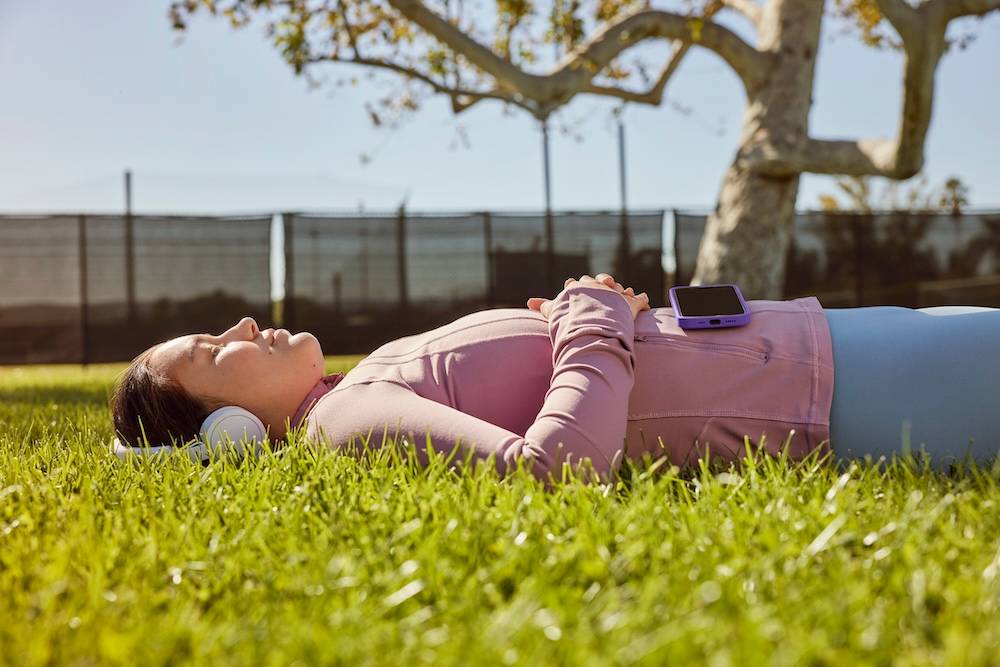White Noise for Sleep: How it Can Help You Get Better Rest
Last Updated May 6, 2025

Falling asleep after a day packed with pings, buzzes, and endless noise can feel almost impossible.
Sound familiar? You're not alone. With so much stimulation, truly restful sleep feels rarer than ever.
Surprisingly, the right sounds can actually help you unwind. The soft hum of a fan or the soothing patter of rain helps millions drift off faster and get better sleep every night.
But sleep isn’t one-size-fits-all. What sends one person into dreamland might keep someone else wide awake. That's why understanding how white noise works — and how to use it the right way — can make all the difference.
What Is White Noise (and How Is It Different From Other Sounds)?
White noise is a constant sound that contains the entire spectrum of frequencies and all sound waves at the same volume. It’s like a steady hum that plays all audible sounds at once. This special quality helps it mask other disruptive sounds in your environment by creating a consistent background that helps your brain filter out unwanted noise.
You’ve already heard white noise in your daily life, though, as it happens quite frequently:
- The static from an untuned television or radio
- The steady hum of an air conditioner running
- An old whirring fan
- A shower with a consistent spray
White noise works so well because it reduces the contrast between background sounds and noises that might interrupt your sleep or break your concentration. If you’re trying to sleep or study in a noisy apartment, for example, white noise helps mask unpredictable sounds like car horns or doors slamming shut.
However, white noise isn’t the only color of noise out there. There are different noise colors with unique sound patterns that might work better for different needs or different people.
Pink Noise
Pink noise contains all the same sound frequencies as white noise but emphasizes the lower ones and reduces the higher ones. This creates a deeper sound that many people find more natural and pleasant than white noise.
Pink noise sounds more like you’d hear in nature:
- Steady rainfall
- Rustling leaves
- Gentle ocean waves
Brown Noise
Brown noise focuses on even lower frequencies than pink noise, which creates a deeper, richer sound with almost no high-frequency hiss. This gives it a rumbling quality similar to:
- Distant thunder
- Strong waterfall sounds
- Deep river currents
- The low rumble of strong wind
Many people who find white noise too harsh or irritating prefer brown noise for its depth and warmth. Brown noise works especially well for studying and concentration, as its rumbling quality can create a more immersive environment that blocks out distractions without being distracting itself. Try different types of noise colors to see which one works best for you.
Why People Use White Noise for Sleep
If you’ve ever fallen asleep to the steady hum or a fan or the gentle patter of rain, then you’ve already experienced what it’s like to use white noise for sleep. This has become an increasingly popular sleep aid, with more than a third of all Americans using it to fall asleep and almost half of all Gen Z relying on it, according to a Newsweek survey.
And it’s easy to see why white noise has caught on. Between noisy neighbors and partners who snore, getting deep sleep can feel impossible. White noise creates a consistent sound that drowns out unpredictable noises that jolt you away just as you’re drifting off.
The Science Behind White Noise and Sleep
White noise might sound like a techy sleep hack, but at its core, it’s just a steady, soothing sound that helps quiet your world. And there's science behind the buzz — here's what white noise can do for your slumber.
Sleep Quality
A recent 12-week study compared people using white noise to those who didn’t, and found that the white noise group fell asleep faster, slept more efficiently, and reported better overall sleep, according to the National Library of Medicine.
Stress Reduction
If you find the sound of rainfall relaxing, then you may already see where this is going. A recent study found that white noise helps reduce stress in university students, according to the Queen’s Science Undergraduate Research Journal. If it can relax some of the most chronically stressed-out people out there, imagine what it does to your sleep.
Blocking Distractions
Everyone has had to deal with trying to fall asleep when the neighbor’s dog won’t stop barking or when your partner or roommate is snoring like a freight train. Well, white noise can help! Using it is an effective way to block out these kinds of unwanted noises and create a calmer mental state, according to the Noise & Health journal. This can help you fall asleep and stay asleep more easily, even in super noisy environments.
Faster Sleep Onset
If counting sheep isn’t helping you fall asleep faster, then white noise just might. People who listen to white noise when they go to bed fall asleep almost 40% faster than those who don’t, according to a study published by the National Center for Biotechnology Information. That’s a lot of time if it usually takes you 30 minutes to fall asleep!
Can White Noise Harm Sleep?
White noise works wonders for many people, but it’s not magic for everyone. Even if you find that it works really well at first, it’s important to be careful of possible challenges that could kick in over time. These include:
- Volume concerns: Like many good things in life, white noise is best in moderation. Playing louder white noise might seem like a good idea, but listening to it at 65 decibels (dB) or higher can increase stress levels, according to a Scientific Reports study. Keep it at a gentle background noise level where it’s loud enough to mask disturbances but quiet enough to fade into the background.
- Tinnitus complications: If you already hear ringing in your ears, then adding more noise might not be helpful. Prolonged exposure to white noise could potentially worsen tinnitus symptoms by affecting your central auditory system, according to a study done by JAMA Otolaryngology. If you have tinnitus, talk to your doctor before trying white noise for sleep.
- Children’s development: What works for you might not be best for your little ones. Regular exposure to white noise during sleep could negatively affect auditory and cognitive development in children, according to the Journal of Clinical Sleep Medicine.
Safety Considerations and Age Appropriateness
You can safely use white sleep noise by following some safety precautions, especially when it comes to volume levels and duration of exposure. Different age groups have different sensitivities to sound, so it’s important to adjust your strategy accordingly. In general, it’s a good idea to follow these precautions:
- Adults will want to keep white noise at around 50–60 dB, which is roughly the volume of a quiet conversation.
- For children, keep the white noise at around 45–40 dB, which is similar to the hum of a refrigerator.
- Babies have the most sensitive hearing, so keep white noise under 45 dB and place the source at least 7 feet away from their crib.
- The elderly with hearing loss might need slightly higher volumes, but it’s important to avoid exceeding 65 dB.
- Consider setting a timer for your white noise to turn off after you fall asleep rather than running it all night, especially if you have children.
How To Use White Noise for Better Sleep
Incorporating white noise into your sleep routine is easy-peasy, but only if you know what precautions to take. Whether you’re using a dedicated machine for sleep, a fan, a fitness app, or one of the many household items that naturally create white noise, the key is consistency and finding out what works best for you.
- Pick Your Sound Style
There’s more than one flavor of white noise. Some people prefer the classic “static” sound, while others find comfort in the hum of a fan, soft rainfall, or ocean waves. The key is finding what feels soothing—not distracting—to you.
- Set the Right Volume
Your white noise shouldn’t be loud. It should blend into the background and feel almost invisible. A good rule of thumb? You should be able to talk over it without raising your voice.
- Use a Timer—Or Don’t
Some people love having white noise all night. Others only need it to fall asleep. Most apps and machines let you set a timer, so play around with what works best for your sleep patterns.
- Make It a Consistent Part of Your Routine
Sleep thrives on routine. Turning on white noise at the same time every night can become a cue to your body and brain that it’s time to wind down. Pair it with other evidence-based sleep practices can multiply its effectiveness and let you rest easy. Try the following elements of a successful sleep routine:
- Start with a wind-down period: Your bedtime routine starts before you even crawl into bed. Start about 30 to 60 minutes before you plan to sleep by turning on your white noise machine or app while you get ready for bed. This helps your brain start associating the sound with sleep preparation.
- Combine with meditation: Apps like Headspace have guided sleep meditations that work like magic with white noise music in the background. The combination of deep breathing with white noise soundscapes is so powerfully relaxing that you’ll be ready for bed by the time you’re done.
- Track your results: Use a sleep tracking app like Sleep Cycle to monitor how white noise affects your sleep quality. You might find that you’ll wake up fewer times overnight or that your sleep score has increased.
- Add gentle stretching: A brief stretching routine using apps like Stretchit before bed can help release some of the physical tension that’s keeping you awake. Focus on gentle stretches for your neck, shoulders, lower back, and hamstrings to relax.
Making Sleep Work for You
White noise can be a powerful aid to your sleep, helping you create a restful environment that promotes better sleep. From blocking out distractions to reducing the time it takes to fall asleep, the benefits of sleep quality extend far beyond just feeling refreshed in the morning.
You might already have access to Wellhub through your employee benefits, which includes premium meditation apps and sleep tools to improve your sleeping routine. Click here to see if you’re eligible and start exploring better sleep options today. If your company doesn’t have Wellhub yet, you can start a petition to bring these wellbeing resources straight to you benefits package.

Want Wellhub at your company? Start a petition.
It’s completely confidential! Just follow a few steps and we'll create your official company petition page.
References
- Attarha, M., Bigelow, J., & Merzenich, M. M. (2018). Unintended Consequences of White Noise Therapy for Tinnitus—Otolaryngology’s Cobra Effect. JAMA Otolaryngology–Head & Neck Surgery, 144(10), 938. https://doi.org/10.1001/jamaoto.2018.1856
- Awada, M., Becerik-Gerber, B., Lucas, G., & Roll, S. (2022). Cognitive performance, creativity and stress levels of neurotypical young adults under different white noise levels. Scientific Reports, 12(1). https://doi.org/10.1038/s41598-022-18862-w
- Beresford, J. (2024, November 23). Gen Z’s White Noise Habit. Newsweek. https://www.newsweek.com/gen-zs-white-noise-habit-1989479
- De Jong, R. W., Davis, G. S., Chelf, C. J., Marinelli, J. P., Erbele, I. D., & Bowe, S. N. (2024). Continuous white noise exposure during sleep and childhood development: A scoping review. Sleep Medicine, 119, 88–94. https://doi.org/10.1016/j.sleep.2024.04.006
- Ganea, A., Kwan, W., Kwan, D., Subbiah, A., He, M., Xu, F., Hasan Al-Hasani, & Kim, G. (2025). Examining the Impact of White Noise on Stress and Cognitive Performance in University Students. Queen’s Science Undergraduate Research Journal, 8. https://doi.org/10.71044/qsurjvol820257
- Yoon, H., & Baek, H. J. (2022). External Auditory Stimulation as a Non-Pharmacological Sleep Aid. Sensors, 22(3), 1264. https://doi.org/10.3390/s22031264
- Zhu, L., & Zheng, L. (2024a). April-June 2024 - Volume 26 - Issue 121 : Noise and Health. Lww.com. https://journals.lww.com/nohe/fulltext/2024/26210/influence_of_white_sound_on_sleep_quality
- Zhu, L., & Zheng, L. (2024b). Influence of White Sound on Sleep Quality, Anxiety, and Depression in Patients with Schizophrenia. Noise & Health, 26(121), 97–101. https://doi.org/10.4103/nah.nah_116_23
Category
Share

The Wellhub Editorial Team empowers HR leaders to support worker wellbeing. Our original research, trend analyses, and helpful how-tos provide the tools they need to improve workforce wellness in today's fast-shifting professional landscape.
Subscribe
Our weekly newsletter is your source of education and inspiration to help you create a corporate wellness program that actually matters.
Subscribe
Our weekly newsletter is your source of education and inspiration to help you create a corporate wellness program that actually matters.
You May Also Like

Women Gym Owners And Founders To Celebrate This International Women’s Day | Wellhub
For International Women’s Day, we put the spotlight on women-owned and founded gyms across the country that deserve a moment to shine.

Black-Owned And Founded Fitness And Wellness Businesses To Support
Check out these black-owned and founded gyms, studios, and fitness and wellness companies and the many ways you can support them.

5 Fun Workouts To Spice Up Your Fitness Routine | Wellhub
Here are five fun workouts and studios to shake up your circuit and keep your fitness routine from falling into an exercise rut.